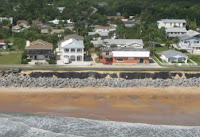The primary purpose of an hurricane and storm damage reduction (HSDR) project is to reduce storm damage to the coastal infrastructure, including residential and commercial property and public facilities. The federal objective is to maximize National Economic Development benefits relative to cost. While environmental quality and recreational benefits are also important, the Corps is required to plan for maximum storm damage reduction benefits.
Is there a specific objective for the Flagler County HSDR project?
Beach and dune erosion, both long-term and storm induced, is the greatest problem in the Flagler County area. Due to the unique beach sediments and proximity of A1A and existing coastal development, Flagler County’s dune system is experiencing a long-term erosion trend with little opportunity for natural recovery. The establishment of a functional dune system will be key in meeting the study objectives to reduce damages to infrastructure and maintain environmental quality.
How does an HSDR project begin?
A Corps civil works project begins when a local community experiences a water resources problem beyond their ability to solve, and Congress directs the Corps to investigate the identified problem.
Upon receiving the authority from Congress to study a potential project, the Corps begins by developing a Reconnaissance Report to specify and document existing conditions, problems and opportunities. This determines the federal interest in the project.
The next step is a Feasibility Study, in which the Corps determines if a project is environmentally acceptable and economically justified. During the Feasibility Study, and as required by the National Environmental Policy Act (NEPA) the Corps actively seeks input from all interested parties, to ensure that it has as much information as possible to use in developing and evaluating alternatives and selecting a recommended plan.
Upon completion and approval of the Feasibility Study, the project must be authorized by Congress via a Water Resources Development Act (WRDA) bill and funded through an Energy and Water Development Appropriations Act bill before the Corps may proceed to contract for project construction.
At what stage of the process is the Flagler County HSDR project?
The Corps is currently in the Feasibility Study phase, conducting scoping (soliciting input) activities and formulating potential alternative plans.
How long does the process take?
In the case of Flagler County, the authority for conducting the study was provided by Congress in May 2002. The Reconnaissance Report, indicating a federal interest in conducting a Feasibility Study (FS), was completed,and a cost-sharing agreement with Flagler County was executed in 2004.
The Feasibility Study began in 2008. Subject to the availability of federal funding, the FS and Environmental Impact Statement (EIS) is scheduled to be completed by 2014. Upon completion and approval of the FS, the project must be authorized by Congress and funds must be appropriated.
How much will the Feasibility Study and EIS cost?
To date, approximately $1.5 million has been spent. It is expected that the total cost of the completed Feasibility Study and EIS will be $3.5 million.
Why does the process take so long?
In accordance with NEPA and Corps policy, the Corps follows a very thorough, methodical process to ensure that the potential federal project is environmentally acceptable and economically justified. Further, the Corps is unable to move a project forward without appropriate authority and associated federal and non-federal funding.
What kinds of alternatives do you consider for HSDR projects?
The Corps considers both non-structural and structural measures. Non-structural measures may include implementing a coastal construction control line and/or a moratorium on construction, buy-out/relocation and/or flood-proofing of structures, or no action at all. Structural measures may include seawalls, revetments, sand-covered soft structures, beach nourishment, groins, submerged artificial reef, and dunes and vegetation.
What are the topics for which you seek public input during the scoping phase?
The Corps is seeking public input on environmental, engineering and economic concerns, cultural resources, study objectives and features; as well as suggested alternatives, scientific data collection and study improvements.
How can interested parties participate in the process?
Written comments will be accepted by mail to:
U.S. Army Corps of Engineers
Jacksonville District
ATTN: Kathleen McConnell (CESAJ-PD-EC)
701 San Marco Boulevard
Jacksonville, FL 32207
Or e-mail to:
Flagler.HSDRComments@usace.army.mil.
The public will also be invited to participate in workshops and public meetings at appropriate times throughout the process, where verbal and written comments will be accepted and considered.
Download the brochure here (PDF).


